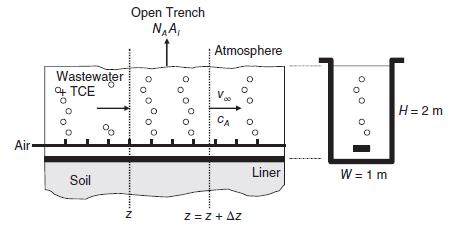Consider the remediation trench shown in the figure below, a simple process to treat contaminated wastewater before
Question:
Consider the remediation trench shown in the figure below, a simple process to treat contaminated wastewater before discharge to a lake or river. The remediation trench consists of a narrow outdoor open channel with an air sparger aligned along the bottom of the trench. Wastewater containing a volatile contaminant dissolved in the water enters one end of the trench. As the wastewater flows down the trench, the aeration gas strips out the dissolved volatile solute and transfers it to the surrounding atmosphere by an interphase mass-transfer process. Consequently the concentration of the solute in the wastewater decreases down the length of the trench. Remediation trenches can be long, and may extend from a holding pond to the discharge point. We wish to design an aerated remediation trench to treat wastewater contaminated with trichloroethylene (TCE) at a concentration of 50 mg/L (50 g TCE/m3) wastewater. The trench is an open duct of width (W) 1.0 m and depth (H) 2.0 m, and the volumetric flow rate of wastewater added to the trench is 0.10 m3/s. Air is sparged into the bottom of the duct at a rate that provides a gas holdup of 0.02 m3 of gas per 1.0 m3 of water, and the average bubble diameter is 1.0 cm (0.01 m). Determine the length of the trench necessary to reduce the effluent TCE concentration to 0.05 mg/L. The process temperature is 293 K and the total system pressure is 1.0 atm. TCE is only sparingly soluble in water, and the Henry’s law constant for TCE in liquid water is 9.98 atm m3/kgmole and the molecular weight of TCE is 131.4 g/gmole.

Step by Step Answer:

Fundamentals Of Momentum Heat And Mass Transfer
ISBN: 9781119723547
7th Edition
Authors: James Welty, Gregory L. Rorrer, David G. Foster





